Update:
2016-08-17 05:59 AM -0400
TIL
Speaking Mon-Myan Language
spk-all-2.htm
by U Kyaw Tun (UKT) (M.S., I.P.S.T., USA),
Daw Khin Wutyi, and staff of Tun
Institute of Learning (TIL).
from Learn Mon Yourself :
pronouncing all 61 lessons (Spk-all):
Downloaded and set in HTML by UKT and
staff of TIL . Not for sale. No
copyright. Free for everyone.
Prepared for students and staff of
TIL Computing and
Language Center, Yangon, MYANMAR :
http://www.tuninst.net ,
www.romabama.blogspot.com
index.htm |
Top
spk-all-indx.htm
UKT151018: Original Video & SND for each lesson in Lesson groups are in
the TIL SD-Library, and you will not hear them unless you are on a TIL computer.
SpkAll group #02
Speak All Lesson group#02, lessons10-15
Lesson 10
Lesson 11
Lesson 12
Lesson 13
Lesson 14
Lesson 15
UKT notes
Contents of this page
UKT160811: original Video & SND for each
lesson in Lesson group #10 is TIL SD-Library
SN-SpkAll-les10-61<Ô> /
bkp10<Ô> (link chk 160810),
& lesson10-61<)) [UKT160814: due to a misunderstanding by my staff
some lessons in <)) have been cut into cap<)) & txt<)), and deleting the
uncut<)). These will be corrected later.
Unless you are on a TIL research computer, programmes such as
SN-SpkAll-les10-61<Ô> /
bkp10<Ô> (link chk 160810)
will not available for you.
However, for uploading to the Internet, each lesson each lesson is changed into
<)) format, e.g. lesson10-61<)) .
This, for some, is cut into two, one giving the caption, and the other the text,
e.g.
lesson10-61cap<)), and
lesson10-61-txt<)) .
UKT 160813 note to TIL-editor : lesson12-61<))
is cut to lesson12-61cap<)) & lesson12-61txt<)) .
Make sure they are all in the same folder, by moving lesson12-61cap<)) &
lesson12-61txt<)) from cap-txt folder and renaming them.
UKT 140605, 150930 : Romabama
 {ro:ma.ba.ma} transcription is based on
Bur-Myan phonology. It is not applicable
to Mon-Myan. The reason is Bur-Myan belongs
to Tib-Bur (Tibeto-Burman) linguistic group,
whereas Mon-Myan is an Austro-Asiatic group.
It belongs to the same group as Tamil, and
other south Indic languages. You can learn
something about language groups in my
section on
{ro:ma.ba.ma} transcription is based on
Bur-Myan phonology. It is not applicable
to Mon-Myan. The reason is Bur-Myan belongs
to Tib-Bur (Tibeto-Burman) linguistic group,
whereas Mon-Myan is an Austro-Asiatic group.
It belongs to the same group as Tamil, and
other south Indic languages. You can learn
something about language groups in my
section on
¤ Buddhist Hybrid Sanskrit Grammar
and Dictionary by
Franklin Edgerton, 1885–1963, (FE-BHS)
-
BHS-indx.htm (link chk 160812)
and proceed to Indic scripts : the
derivatives of Asokan - by UKT
-
indic-indx.htm (link chk 160812)
- from Unicode Standard Version 4 by
Unicode Consortium ,
The scripts to be studied for comparison
to Bur-Myan & Mon-Myan:
1. Devanagari, for comparison to Pal-Myan
- deva.htm (link chk 160812)
2. Bengali, for comparison to Bur-Myan
- bing.htm (link chk 160812)
3. Tamil, for comparison to Mon-Myan
- tami.htm (link chk 160812)
The only commonality between Bur-Myan &
Mon-Myan is the Myanmar script, the common
script of indigenous ethnic groups of
Myanmarpré including Karen, Pao, and Shan.
Because of this I have decided to give only
the orthography and the meaning. I have
given some Romabama transcriptions. You can
sometimes get meaning from the Myanmar akshara, because Bama and Mon ethnic
groups have been living together for centuries, sharing the same Theravada
Buddhist religion, Pal-Myan language, and many folk beliefs.
It has been observed again and again that speech divides peoples, but script
unites them. Perhaps the oldest account of discrimination based on speech
(pronunciation) is found in the Book of Judges in the Christian
Bible account of Shibboleth when thousands of people were killed.
See Wikipedia:
http://en.wikipedia.org/wiki/Shibboleth 140605
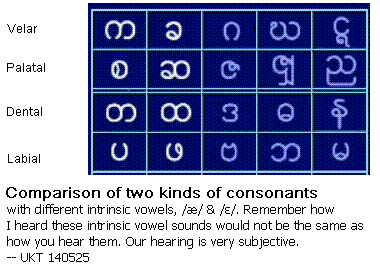 Note /ɛ/ & /e/ are front mid-vowels.
How you "hear" them is very
subjective - Eng-Lat speakers do not
even notice the presence of /ɛ/.
Note /ɛ/ & /e/ are front mid-vowels.
How you "hear" them is very
subjective - Eng-Lat speakers do not
even notice the presence of /ɛ/.
I have represented this intrinsic vowel
in Romabama as {é} (English represent this as {e}) but NMT as {è.} --
see NMT pdf p024. In the vicinity of
another consonant, the intrinsic vowel
of c1-c2 remains as /æ/. However, in
the vicinity of certain consonants, the
intrinsic vowel of c3-c4, not only changes into /æ/, but the basic
akshara itself comes to sound like c1-c2.
Thus /{ge.ta.}/ becomes /{ka.ta.}/.
Listen to Lesson Spk-all 12 lesson12-61-txt<))
(first line with three words),
concentrating on
 {Be-we-ge-ta.} which comes to sound
like /{Be-we-ka.-ta.}/.
{Be-we-ge-ta.} which comes to sound
like /{Be-we-ka.-ta.}/.

This well designed programme has become
almost useless because of poor visual
presentation. There are 2 faults.
First,
the back ground of lessons in blue-black colour is too intense, and, secondly,
the font is not well designed. I have
tried to remedy these defects by
rewriting text from a
Lakkwak --
lakkwak.gif
(link chk 160814).

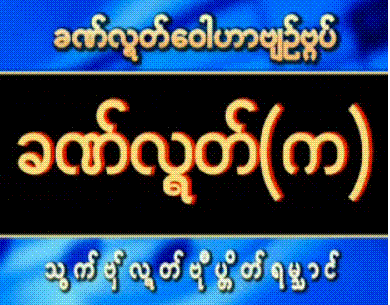 lesson10-61cap<))
lesson10-61cap<))




 Go vertical.
lesson10-61-txt<))
Go vertical.
lesson10-61-txt<))
I have given the Romabama spellings
only to relate sound to spelling.
Remember, Mon-Myan has a different
phonology, and Romabama transcriptions
do not hold. To see Mon to Burmese
translation by U Nai San Thein, click
on
- NST-ka-hka-group.gif .
Fundamentals of Mon Speech &
Script (in Bur-Myan), by
Naing Maung Toe, www.monlibrary.com, Yangon,
2007 (Romabama may be applicable in NMT)
-
MonMyan-NMgToe-Mon-Bur<Ô>
/ bkp<Ô>
(link chk 160809)
also gives meanings (gloss) in Bur-Myan for words similar to the above on page
23-24.
Caveat: NMT's lessons are numbered differently from
Spk-all. However, in my bookmarks you will see Spk-all numbers. e.g. NMT lesson
2, is bookmarked as: NMT-les10.
Contents of this page
SN-SpkAll-les11-61<Ô> /
bkp11<Ô> (link chk 160810),
& lesson11-60<))
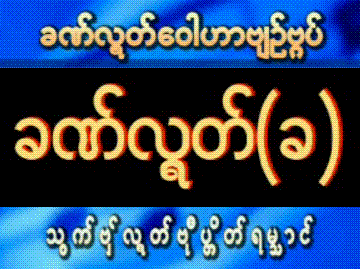 les11-61cap<))
les11-61cap<))

Now listen to Lesson 11.
Go vertical.
les11-61txt<))
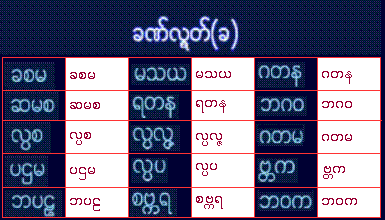
Contents of this page
SN-SpkAll-les12-61<Ô> /
bkp12<Ô>, &
lesson12-61<)) (link chk 160810)
UKT 160813 note to TIL-editor : lesson12-61<))
is cut to lesson12-61cap<)) & lesson12-61txt<)) .
Make sure they are all in the same folder, by moving lesson12-61cap<)) &
lesson12-61txt<)) from cap-txt folder and renaming them.
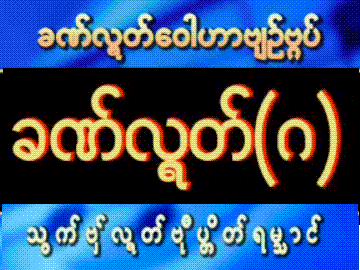 lesson12-61cap<))
lesson12-61cap<))
Listen to Lesson 12. Go horizontal.
lesson12-61txt<))

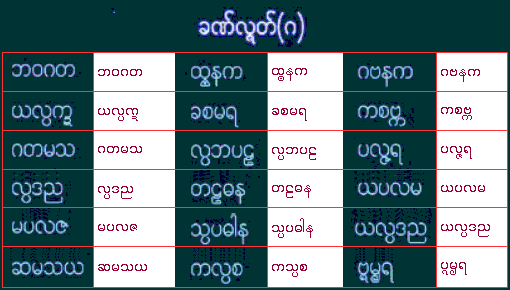
Contents of this page
SN-SpkAll-les13-61<Ô> /
bkp13<Ô> , &
lesson13-61<)) (link chk 160810)
Note: There is a mix-up in my hyperlinks and I am giving what is in the folder
- lesson13-61cap1<)) ;
lesson13-61txt1<))
- lesson13-61-1<)); -
lesson13-61-2<))
Note: There are two parts in this lesson.
The sound link gives both one after another. These have been separated by my
assistant Daw Khin Wutyi and her staff. I have given the respective cuts below.
 - lesson13-61-1<))
- lesson13-61-1<))
 - lesson13-61txt1<))
- lesson13-61txt1<))
Lesson 13 Part 2
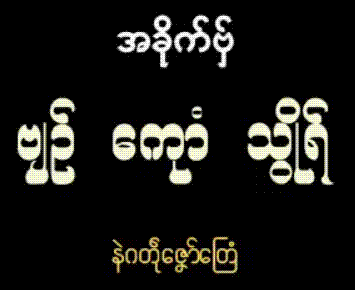 - lesson13-61cap1<))
- lesson13-61cap1<))
 -
lesson13-61-2<))
-
lesson13-61-2<))
Contents of this page
SN-SpkAll-les14-61<Ô> /
bkp14<Ô> (link chk 160810) &
lesson14-61<))
UKT 160817: This lesson is similar to Lesson 13, in which {ka.} changes are
described. In Lesson 14, we find {a.} changes
 - lesson14-61cap<))
- lesson14-61cap<))
 For comparison see on the right, {ka.} changes described with red letters.
For comparison see on the right, {ka.} changes described with red letters.
Here in Lesson 14, you see {a.} changes.
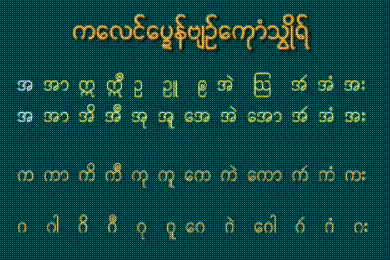 -
lesson14-61txt<))
-
lesson14-61txt<))
UKT to TIL editor 130410. Without the colour changes of the internet
website, the following two panels are not more instructive than the above, and
may be omitted.

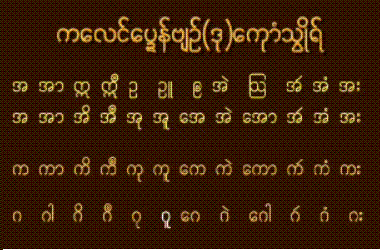
Contents of this page
SN-SpkAll-les15-61<Ô> /
bkp15<Ô> , &
lesson15-61<)) (link chk 160810)
UKT 130410: The reader is reading column by column.


UKT 140616: the following
are enlarged and cut columns. The
original txt was too small and already
blurred to read. The following is my
transcription corrected by Daw Mi. Htay Kyi.
I am going over them one by one learning
the pronunciations. She has also translated
the text, but at this stage, I am not
interested in the meanings. You can find
her translation in PIX. My interest is just
to relate sound to spelling.
lesson15-61<))
15-s1 lesson15-61s1<))
15-s2 lesson15-61s2<))
15-s3 lesson15-61s3<))
15-s4 lesson15-61s4<))
 -------------
-------------
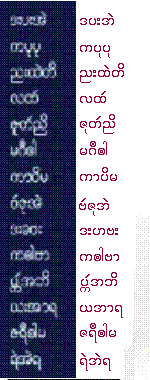 -------------
-------------
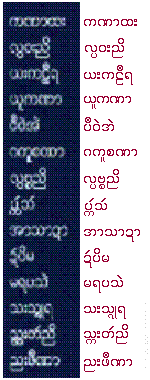 -------------
-------------

Contents of this page
Contents of this page
End TIL file
![]() {ro:ma.ba.ma} transcription is based on
Bur-Myan phonology. It is not applicable
to Mon-Myan. The reason is Bur-Myan belongs
to Tib-Bur (Tibeto-Burman) linguistic group,
whereas Mon-Myan is an Austro-Asiatic group.
It belongs to the same group as Tamil, and
other south Indic languages. You can learn
something about language groups in my
section on
{ro:ma.ba.ma} transcription is based on
Bur-Myan phonology. It is not applicable
to Mon-Myan. The reason is Bur-Myan belongs
to Tib-Bur (Tibeto-Burman) linguistic group,
whereas Mon-Myan is an Austro-Asiatic group.
It belongs to the same group as Tamil, and
other south Indic languages. You can learn
something about language groups in my
section on  Note /ɛ/ & /e/ are front mid-vowels.
How you "hear" them is very
subjective - Eng-Lat speakers do not
even notice the presence of /ɛ/.
Note /ɛ/ & /e/ are front mid-vowels.
How you "hear" them is very
subjective - Eng-Lat speakers do not
even notice the presence of /ɛ/. ![]() {Be-we-ge-ta.} which comes to sound
like /{Be-we-ka.-ta.}/.
{Be-we-ge-ta.} which comes to sound
like /{Be-we-ka.-ta.}/. 






 Go vertical.
Go vertical.






 -
-  -
-  -
-  -
-
 -
-  -
-




 -------------
-------------
 -------------
-------------
 -------------
-------------
